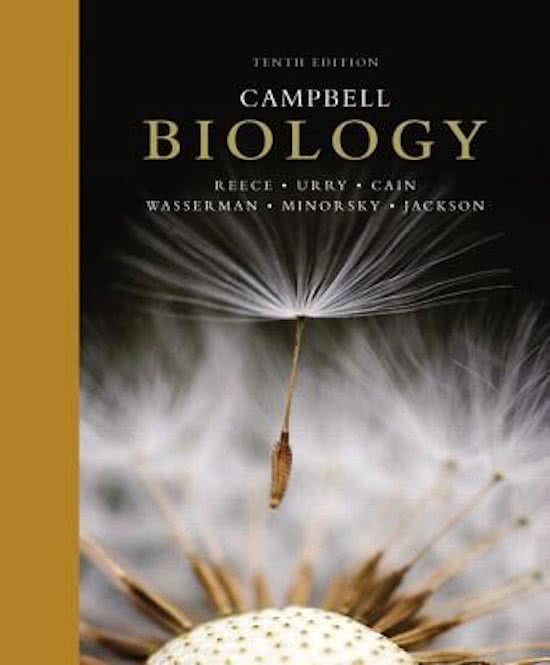
- ISBN
- Autor(es)
- Idioma
- Editorial
- Edición
- Edición
- Relacionados:
Campbell Biology Resúmenes (10.º edición)
Jane B. Reece, Lisa A. Urry - ISBN: 9780321775658
- ISBN
- Autor(es)
- Idioma
- Editorial
- Edición
- Edición
- Relacionados
Ver todos los 25 resúmenes de Campbell Biology, escritos por Jane B. Reece, Lisa A. Urry. Los resúmenes de Campbell Biology en Stuvia están escritos por estudiantes o profesores, lo que facilita y acelera la comprensión del contenido del libro de texto. Encontrar el resumen que se adapte perfectamente a tu estilo de aprendizaje hará que estudiar sea mucho más fácil.
Resúmenes más vendidos de Campbell Biology
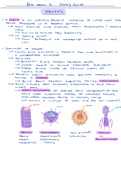
Condensed notes from in-class lectures, slides, and textbook. Broken down in an approachable way with lots of illustrations and diagrams. These were my notes from the third test of the term, but definitely check your syllabus because it might differ slightly. Pink highlighted words are key terms, orange highlights are key concepts, and anything highlighted in yellow is something that was specifically called out during lecture as something that was important/might be specifically tested on.
- Notas de lectura
- • 18 páginas •
Condensed notes from in-class lectures, slides, and textbook. Broken down in an approachable way with lots of illustrations and diagrams. These were my notes from the third test of the term, but definitely check your syllabus because it might differ slightly. Pink highlighted words are key terms, orange highlights are key concepts, and anything highlighted in yellow is something that was specifically called out during lecture as something that was important/might be specifically tested on.
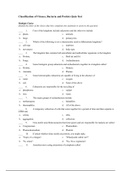
Classification of Viruses, Bacteria and Protists Quiz-Test Multiple Choice Identify the letter of the choice that best completes the statement or answers the question. ____ 1. Four of the kingdoms include eukaryotes and the other two include ____ 2. Which of the following is not a characteristic used to differentiate kingdoms? ____ 3. The kingdom that contains both unicellular and multicellular organisms is the kingdom ____ 4. Some biologists group eubacteria and archaebacteria together in a kin...
- Respuestas
- • 9 páginas •
Classification of Viruses, Bacteria and Protists Quiz-Test Multiple Choice Identify the letter of the choice that best completes the statement or answers the question. ____ 1. Four of the kingdoms include eukaryotes and the other two include ____ 2. Which of the following is not a characteristic used to differentiate kingdoms? ____ 3. The kingdom that contains both unicellular and multicellular organisms is the kingdom ____ 4. Some biologists group eubacteria and archaebacteria together in a kin...
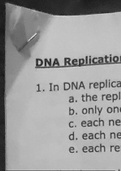
1. In his work with pneumonia-causing bacteria and mice, Griffith found that a. the protein coat from pathogenic cells was able to transform nonpathogenic cells. b. heat-killed pathogenic cells caused pneumonia. c. some substance from pathogenic cells was transferred to nonpathogenic cells, making them pathogenic. d. the polysaccharide coat of bacteria caused pneumonia. e. bacteriophages injected DNA into bacteria. 2. What is the basis for the difference in how the leading and lagging strands of...
- Examen
- • 12 páginas •
1. In his work with pneumonia-causing bacteria and mice, Griffith found that a. the protein coat from pathogenic cells was able to transform nonpathogenic cells. b. heat-killed pathogenic cells caused pneumonia. c. some substance from pathogenic cells was transferred to nonpathogenic cells, making them pathogenic. d. the polysaccharide coat of bacteria caused pneumonia. e. bacteriophages injected DNA into bacteria. 2. What is the basis for the difference in how the leading and lagging strands of...
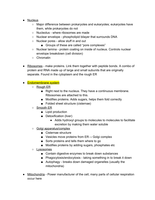
Super detailed test study guide in the simplest terms possible. Includes diagrams and tables where their use simplifies the ideas behind them. Netted an almost perfect score of 99 on an exam using it. Uses colors and underlining to enhance retention, perfect for quick cramming and glancing over.
- Textbook notes
- • 8 páginas •
Super detailed test study guide in the simplest terms possible. Includes diagrams and tables where their use simplifies the ideas behind them. Netted an almost perfect score of 99 on an exam using it. Uses colors and underlining to enhance retention, perfect for quick cramming and glancing over.
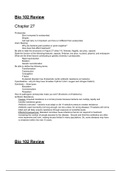
Prokaryotes Size (compared to eukaryotes) Shapes Cell wall (why is it important, and how is it different than eukaryotes) Gram Staining Why are bacteria gram-positive or gram-negative? How does that affect treatment? Be able to label the structures on Figure 27 (slide 14): fimbriae, flagella, sex pilus, capsule State the function of the following features: capsule, fimbriae, sex pilus, nucleoid, plasmid, and endospore What are the three factors contributing to genetic diversity in prokaryotes...
- Examen
- • 17 páginas •
Prokaryotes Size (compared to eukaryotes) Shapes Cell wall (why is it important, and how is it different than eukaryotes) Gram Staining Why are bacteria gram-positive or gram-negative? How does that affect treatment? Be able to label the structures on Figure 27 (slide 14): fimbriae, flagella, sex pilus, capsule State the function of the following features: capsule, fimbriae, sex pilus, nucleoid, plasmid, and endospore What are the three factors contributing to genetic diversity in prokaryotes...
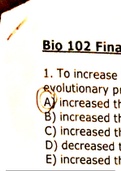
Body fluids of an osmoconformer would be ________ with its _________ environment. a. hyperosmotic; freshwater b. isotonic; freshwater c. hyperosmotic; saltwater d. isoosmotic; saltwater e. hyposmotic; saltwater 2. A freshwater fish was accidently placed in salt water, and died after several minutes. Why? a. Loss of water by osmosis in cells in vital organs resulting in cell death and organ failure. b. Salt diffused into all of the fish’s cells causing them to swell and lyse. c. The kidneys...
- Examen
- • 14 páginas •
Body fluids of an osmoconformer would be ________ with its _________ environment. a. hyperosmotic; freshwater b. isotonic; freshwater c. hyperosmotic; saltwater d. isoosmotic; saltwater e. hyposmotic; saltwater 2. A freshwater fish was accidently placed in salt water, and died after several minutes. Why? a. Loss of water by osmosis in cells in vital organs resulting in cell death and organ failure. b. Salt diffused into all of the fish’s cells causing them to swell and lyse. c. The kidneys...
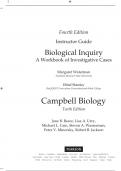
Excel in Your Studies with [Campbell Biology,Reece,10e] Solutions Manual! Ready to take your academic performance to new heights? Our Solutions Manual for [Campbell Biology,Reece,10e] is your secret weapon. Gain access to verified answers that will help you ace exams and assignments. With our comprehensive solutions, you'll be able to grasp complex concepts and apply them confidently. Don't settle for average, strive for excellence with our Solutions Manual.
- Resumen
- • 202 páginas •
Excel in Your Studies with [Campbell Biology,Reece,10e] Solutions Manual! Ready to take your academic performance to new heights? Our Solutions Manual for [Campbell Biology,Reece,10e] is your secret weapon. Gain access to verified answers that will help you ace exams and assignments. With our comprehensive solutions, you'll be able to grasp complex concepts and apply them confidently. Don't settle for average, strive for excellence with our Solutions Manual.
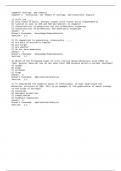
With the Test Bank for [Campbell Biology,Reece,10e], exam preparation has never been easier. Official exams and answers, practice questions, and strategic insights all at your fingertips. Transform your study sessions and pass the class effortlessly in 2023-2024.
- Examen
- • 951 páginas •
With the Test Bank for [Campbell Biology,Reece,10e], exam preparation has never been easier. Official exams and answers, practice questions, and strategic insights all at your fingertips. Transform your study sessions and pass the class effortlessly in 2023-2024.
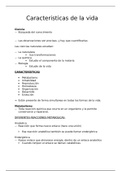
Este documento se trata de los principios de las ciencias; sus caracteristicas. Metabolismo, irritabilidad, reproducción, homeostasia, desarrollo, organización y evolución. Es la primera lectura de la guía de estudio sobre los conceptos de la biología.
- Notas de lectura
- • 2 páginas •
Este documento se trata de los principios de las ciencias; sus caracteristicas. Metabolismo, irritabilidad, reproducción, homeostasia, desarrollo, organización y evolución. Es la primera lectura de la guía de estudio sobre los conceptos de la biología.
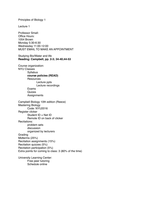
These are the lecture notes associated with the course.
- Notas de lectura
- • 62 páginas •
These are the lecture notes associated with the course.
¿Tienes documentos que coincidan con este libro? ¡Véndelos y gana dinero con tu conocimiento!
Resúmenes más recientes de Campbell Biology
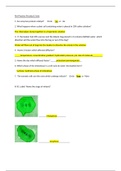
Biology I-For Science Majors-Lab Practical Review #2
- Study guide
- • 7 páginas •
Biology I-For Science Majors-Lab Practical Review #2
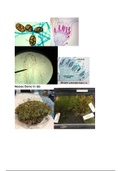
microscope slides LABLED and labeled live demo pictures from Mosses Demo in lab, ferns, antheridia archegonia gametophyte, slides, Sporophyte and Gemmae cup microscope slides, Marchantia antheridium and archegonium life cycle diagrams, liverwort life cycle diagram, Fern microscope slides, fern Gametophyte (Prothallus) life cycle, fern Gametophyte and sporophyte Sorus with sporangia surrounded by annulus microscope slides, Life Cycle slides Phylum Lycophyta-spike moss (Selaginella), microscope sl...
- Visual
- • 14 páginas •
microscope slides LABLED and labeled live demo pictures from Mosses Demo in lab, ferns, antheridia archegonia gametophyte, slides, Sporophyte and Gemmae cup microscope slides, Marchantia antheridium and archegonium life cycle diagrams, liverwort life cycle diagram, Fern microscope slides, fern Gametophyte (Prothallus) life cycle, fern Gametophyte and sporophyte Sorus with sporangia surrounded by annulus microscope slides, Life Cycle slides Phylum Lycophyta-spike moss (Selaginella), microscope sl...
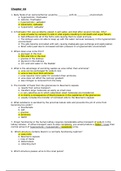
Chapter 44 1. Body fluids of an osmoconformer would be ________ with its _________ environment. a. hyperosmotic; freshwater b. isotonic; freshwater c. hyperosmotic; saltwater d. isoosmotic; saltwater e. hyposmotic; saltwater 2. A freshwater fish was accidently placed in salt water, and died after several minutes. Why? a. Loss of water by osmosis in cells in vital organs resulting in cell death and organ failure. b. Salt diffused into all of the fish’s cells causing them to swell and lyse. ...
- Examen
- • 14 páginas •
Chapter 44 1. Body fluids of an osmoconformer would be ________ with its _________ environment. a. hyperosmotic; freshwater b. isotonic; freshwater c. hyperosmotic; saltwater d. isoosmotic; saltwater e. hyposmotic; saltwater 2. A freshwater fish was accidently placed in salt water, and died after several minutes. Why? a. Loss of water by osmosis in cells in vital organs resulting in cell death and organ failure. b. Salt diffused into all of the fish’s cells causing them to swell and lyse. ...
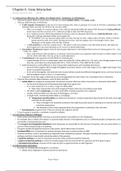
These notes cover gene interaction, gene pathways, penetrance & expressivity, DNA structure, DNA replication, RNA transcription and processing, proteins and their synthesis, and some notes on genetic engineering and amplifying gene fragments. There are 9 pages of notes total.
- Notas de lectura
- • 9 páginas •
These notes cover gene interaction, gene pathways, penetrance & expressivity, DNA structure, DNA replication, RNA transcription and processing, proteins and their synthesis, and some notes on genetic engineering and amplifying gene fragments. There are 9 pages of notes total.

Classification of Viruses, Bacteria and Protists Quiz-Test Multiple Choice Identify the letter of the choice that best completes the statement or answers the question. ____ 1. Four of the kingdoms include eukaryotes and the other two include ____ 2. Which of the following is not a characteristic used to differentiate kingdoms? ____ 3. The kingdom that contains both unicellular and multicellular organisms is the kingdom ____ 4. Some biologists group eubacteria and archaebacteria together in a kin...
- Respuestas
- • 9 páginas •
Classification of Viruses, Bacteria and Protists Quiz-Test Multiple Choice Identify the letter of the choice that best completes the statement or answers the question. ____ 1. Four of the kingdoms include eukaryotes and the other two include ____ 2. Which of the following is not a characteristic used to differentiate kingdoms? ____ 3. The kingdom that contains both unicellular and multicellular organisms is the kingdom ____ 4. Some biologists group eubacteria and archaebacteria together in a kin...
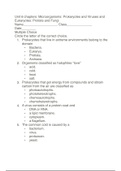
Campbell Reese Biology ch 40-43 final exam study guide questions and answers After surgical removal of the gallbladder, a person must be careful to limit intake of a. starch b. protein c. sugar d. fat e. water Chapter 42 26. What would happen if the amount of interstitial fluid surrounding the capillary beds of the lungs were to increase significantly? a. The amount of CO2 entering the lungs from the blood would increase. b. The amount of CO2 entering the blood from the lungs would in...
- Respuestas
- • 5 páginas •
Campbell Reese Biology ch 40-43 final exam study guide questions and answers After surgical removal of the gallbladder, a person must be careful to limit intake of a. starch b. protein c. sugar d. fat e. water Chapter 42 26. What would happen if the amount of interstitial fluid surrounding the capillary beds of the lungs were to increase significantly? a. The amount of CO2 entering the lungs from the blood would increase. b. The amount of CO2 entering the blood from the lungs would in...

1. In his work with pneumonia-causing bacteria and mice, Griffith found that a. the protein coat from pathogenic cells was able to transform nonpathogenic cells. b. heat-killed pathogenic cells caused pneumonia. c. some substance from pathogenic cells was transferred to nonpathogenic cells, making them pathogenic. d. the polysaccharide coat of bacteria caused pneumonia. e. bacteriophages injected DNA into bacteria. 2. What is the basis for the difference in how the leading and lagging strands of...
- Examen
- • 12 páginas •
1. In his work with pneumonia-causing bacteria and mice, Griffith found that a. the protein coat from pathogenic cells was able to transform nonpathogenic cells. b. heat-killed pathogenic cells caused pneumonia. c. some substance from pathogenic cells was transferred to nonpathogenic cells, making them pathogenic. d. the polysaccharide coat of bacteria caused pneumonia. e. bacteriophages injected DNA into bacteria. 2. What is the basis for the difference in how the leading and lagging strands of...
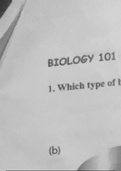
To increase the effectiveness of exchange surfaces in the lungs and intestines, evolutionary pressures have: a. increased the surface area available for exchange b. increased the thickness of these linings c. increased the number of cell layers d. increased the volume of the cells in these linings e. decreased the metabolic rate of the cells in these linings 2. Interstitial fluid provides for the exchange of materials between blood and body cells. 3. The lining of the smallest tubules in the ki...
- Examen
- • 16 páginas •
To increase the effectiveness of exchange surfaces in the lungs and intestines, evolutionary pressures have: a. increased the surface area available for exchange b. increased the thickness of these linings c. increased the number of cell layers d. increased the volume of the cells in these linings e. decreased the metabolic rate of the cells in these linings 2. Interstitial fluid provides for the exchange of materials between blood and body cells. 3. The lining of the smallest tubules in the ki...
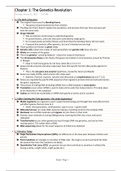
These notes cover the beginning of genetics, gene inheritance, phenotypes vs genotypes, inheritance patterns, independent assortment, gene linkage. The notes are 7-8 pages long. There are some drawn examples of independent assortment that I used, and a table about inheritance I made.
- Notas de lectura
- • 8 páginas •
These notes cover the beginning of genetics, gene inheritance, phenotypes vs genotypes, inheritance patterns, independent assortment, gene linkage. The notes are 7-8 pages long. There are some drawn examples of independent assortment that I used, and a table about inheritance I made.
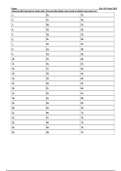
. To increase the effectiveness of exchange surfaces in the lungs and in the intestines, evolutionary pressures have A) increased the surface area available for exchange. B) increased the thickness of these linings. C) increased the number of cell layers. D) decreased the metabolic rate of the cells in these linings. E) increased the volume of the cells in these linings. 2. The lining of the smallest tubules in the kidneys is composed of A) connective tissue. B) smooth muscle cells. C) neural ti...
- Examen
- • 17 páginas •
. To increase the effectiveness of exchange surfaces in the lungs and in the intestines, evolutionary pressures have A) increased the surface area available for exchange. B) increased the thickness of these linings. C) increased the number of cell layers. D) decreased the metabolic rate of the cells in these linings. E) increased the volume of the cells in these linings. 2. The lining of the smallest tubules in the kidneys is composed of A) connective tissue. B) smooth muscle cells. C) neural ti...
¿Tienes documentos que coincidan con este libro? ¡Véndelos y gana dinero con tu conocimiento!
¿Por qué estudiar con los resúmenes de libros sobre Stuvia?

Relevancia, eficiencia y conveniencia. Estos son elementos importantes al estudiar o prepararse para un curso o examen. Estudiar con la ayuda de resúmenes de libros, que están vinculados al número ISBN de su libro (de estudio), es más relevante que nunca. Tus compañeros de estudios o tutores comparten sus conocimientos contigo para ayudarte a prepararte para tus exámenes. Encuentre el número ISBN de su libro y asegúrese de comprar el resumen correcto. De esa manera, no se enfrentará a sorpresas durante sus exámenes.

Todos los resúmenes de Stuvia están escritos por estudiantes que ya han realizado el examen, profesores que enseñan el material de estudio o editores profesionales. Como resultado, puede estar seguro de que comprenderá el material del curso más fácilmente y de que el resumen contiene todos los elementos que se prueban en el examen. Encuentra el libro que necesitas estudiar por su ISBN y elige el mejor resumen de libro de texto.
Sumario Campbell Biology
- New Make Connections Figures pull together content from different chapters visually, helping you see "big picture" relationships.
- New Scientific Skills Exercises in every chapter use real data to build key skills needed for biology, including data analysis, graphing, experimental design, and math skills.
- New examples show you how our ability to sequence DNA and proteins rapidly and inexpensively is transforming every subfield of biology.
